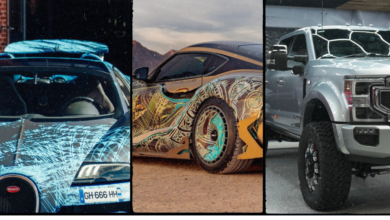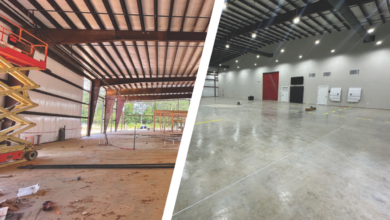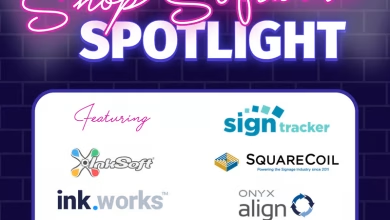Printable window films have really taken off in the retail and commercial markets. Not only are these films used to advertise products and enhance spaces but they also can be used for privacy purposes.
One of the challenges for the retail market is “creating an environment that creates an experience,” says Tim Boxeth, marketing manager for 3M Commercial Solutions. “Because of online shopping, the retailers are looking to create more experiences, so one of the ways we’ve seen them do that is using more graphics in general but also incorporating window graphics into that mix.”
Digital printing allows companies to create an infinite amount of designs on their windows.
Joshua Barnard, product manager, digital print media, for Avery Dennison Graphics Solutions, says that his company is seeing a major focus on retail and point of purchase displays when it comes to window films.
“There has definitely been an increase in the amount of graphics used in retail applications. We see a lot of that,” he says. “The other area we’re seeing a lot of cool projects in is conference rooms and corporate offices.”
Many companies are enhancing their conference room windows with window graphics. Some give glassed in spaces privacy from the outside, while at the same time enhancing the space on the inside with art or a corporate theme.
Avery Dennison Graphics Solutions has numerous options when it comes to window films, including perforated window films, printable white for opaque window applications, transparent and translucent films, clear and translucent colored films, frosted films and architectural films.
3M’s Boxeth says that many corporations want to use these films to “create environments people want to be at and work at or attract younger workers and new workers.”
He adds that window graphics in the past were printed on perforated window films where people on the inside of the window could see out but people on the outside couldn’t see in very well.
“With our clear films, you can create nice looking designs that can be very subtle and noticeable and you can see through the windows much better,” Boxeth says. “That, along with white ink in printers, allows designers and printers to create unique effects on clear film.”
3M calls its window graphics, window wraps.
“We’re definitely committed to this space. We know there’s opportunity here and we’re working to innovate to deliver the next window films and help grow the market,” he says.
Avery Dennison’s Barnard says that since digital printing technology became more accessible, more people have become aware of its capabilities. When people walk down a street and see rows of windows with different graphics in them, they begin to think about all the different ways they can use the technology to enhance their own spaces, he says.
The market for window films will continue to grow as manufacturers add functionality to their products. He says that Avery Dennison invested in a company that has a gauzy film that is clear until a switch is flipped and then it becomes frosted. Companies are interested in using it for conference room spaces. If the conference room is not in use, the windows are clear. If it is in use, the windows become frosted for privacy purposes. The film can also be used in bathrooms.
There’s also interest in window films for grocery store freezers that would keep the glass from frosting up every time the door is opened, he says. Hospitals and hotels are interested in antimicrobial films.
There are a number of benefits to using window films to customize office spaces, Barnard says. In leased office spaces, for instance, companies can use window films to identify the names of conference rooms or the names of employees in offices.
“Instead of laser engraving the glass, you put film on there that gives the same effect of laser engraving,” he says. That way, when a new tenant moves in, it is simple to take off the film and begin again without having to replace the glass.
John Coyne, sales manager at Lintec of America in Schaumberg, Ill., says that his company’s best-selling window film is optically clear. The film can be placed on the inside of a window so clients don’t have to worry about rain or environmental issues ruining their window graphics.
It also can be used for privacy purposes or for window advertisements.
The window graphics market has grown exponentially because “there are only so many banners you can put up,” he says. But there is a ton of high-end, visible window space on buildings. Many high rise buildings won’t let tenants put anything on the outside of the building, but there are no restrictions on the inside, he adds.
“Think about the space and how much it costs to rent; how many people walk by a window. Windows and walls,” he says.
And the space isn’t always used for advertisements. The fastest growing segment of Lintec’s business is architectural and design.
There’s still a lot of advertising and promotional work, especially in retail stores that want to get their point across in their windows, Coyne says. Window films also have industrial applications. Customers use the films as a light diffuser. They will print different designs on the films, which are then put on windows or light fixtures, where the light shines behind the graphic.
“In that application, you don’t want to use vinyl. Light shining on it can shrink it,” Coyne says.
Window films are also used as UV blockers on windows. This is particularly helpful in clothing and furniture stores where the client doesn’t want their products displayed in the windows to fade.
The digital printing market has advanced so much that shops can print window graphics that show one graphic on the inside and another on the outside of the window by using layered inks, Boxeth says.
Begin by reverse printing the image that will be viewed from the second surface, he says. Cover that with a layer of white ink, a layer of black ink and another layer of white ink before you lay the colored ink down for the image that will be viewed on the first surface.
These types of special effects can be used in longer-term architectural graphics or promotional window graphics. They are in high demand in retail, restaurant and hospitality spaces.








